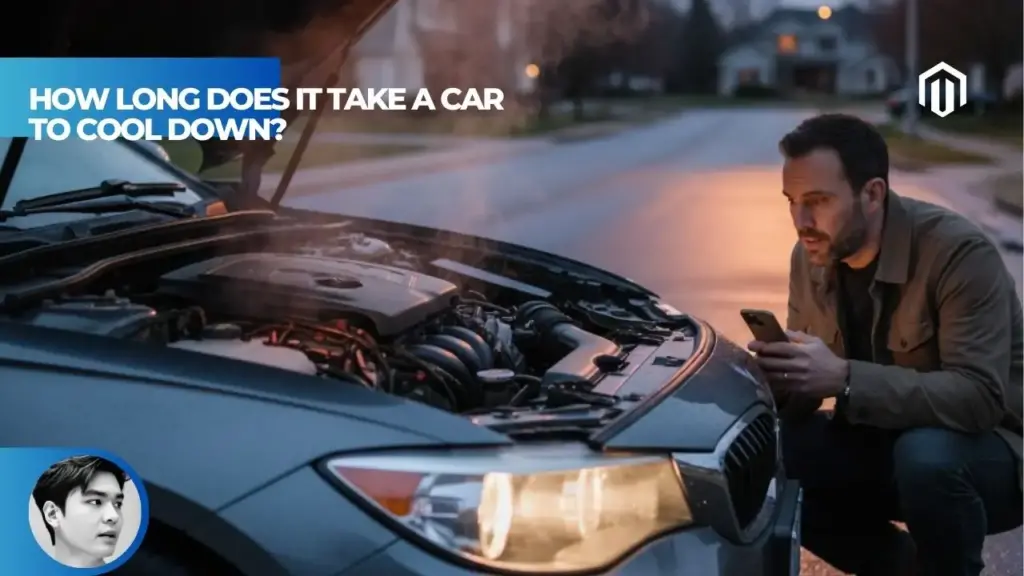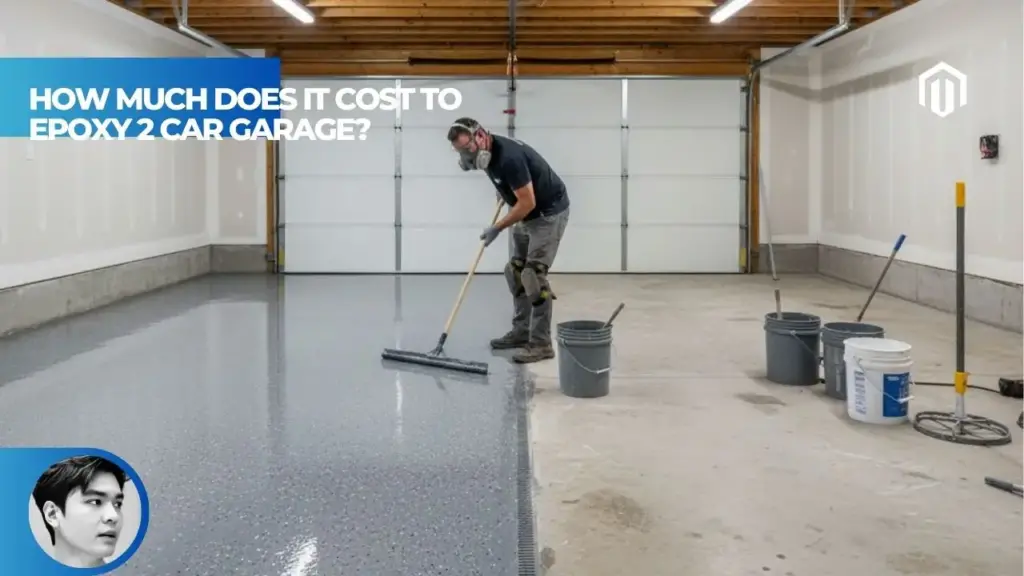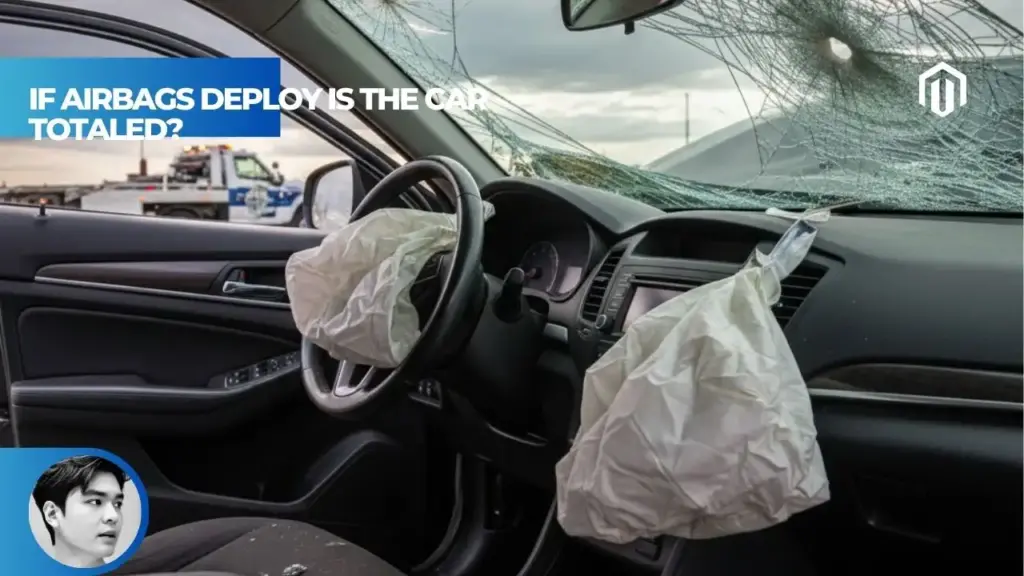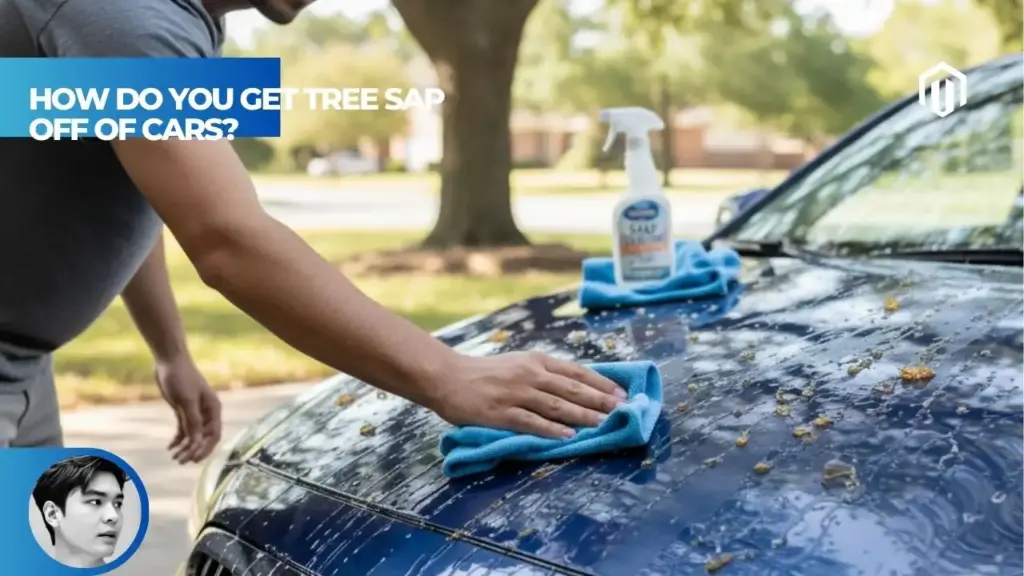You may also like:
- 【Explained】How Can You Tell If Your Car Is Overheating? A Quick Guide to Spotting the First Signs
- 【Explained】How to Fix Car AC Blowing Hot Air? DIY Troubleshooting Guide
- 【Explained】What Coolant Can I Use for BMW? (The G48 Blue vs. HT-12 Green Guide)
- 【Explained】How Long Does It Take to Buy a Car? A Step-by-Step Timeline
- 【Explained】Do You Check Oil When Car Is Hot or Cold? The Simple and Accurate Answer
A car engine typically needs at least 30 minutes to be safely touchable, 1-2 hours before you can open the radiator cap, and 2-3 hours to reach ambient temperature for major maintenance work. If your car has overheated, wait a minimum of 30-45 minutes before attempting to add coolant—and only to the overflow reservoir, never directly to a hot radiator.

How Long for Car Engine to Cool Down
Understanding engine cooling times prevents burns, damage, and costly mistakes. The cooling process follows predictable patterns based on thermodynamics and heat dissipation rates.
30 Minutes for Engine to Cool
After normal operation, your engine requires 30 minutes minimum to cool enough for basic inspection. During this time, surface temperatures drop from around 195-220°F to approximately 120-140°F[1]. This temperature range allows you to briefly touch metal surfaces without severe burns, though components remain uncomfortably hot.
The 30-minute mark represents a critical safety threshold. Internal coolant temperatures have typically dropped below boiling point, reducing pressure within the cooling system. However, the system still maintains 5-10 PSI of residual pressure, making radiator cap removal dangerous.
How Long for Car to Cool Down to Touch
Surface touchability varies by component material and location. Aluminum parts cool faster than cast iron due to superior thermal conductivity—aluminum conducts heat 2-4 times better than cast iron[2]. This means aluminum cylinder heads become touchable in 25-30 minutes while cast iron blocks may require 35-40 minutes.
Key touchability timeline:
- Valve covers: 20-25 minutes
- Intake manifold: 25-30 minutes
- Exhaust manifold: 45-60 minutes
- Engine block: 30-35 minutes
1 Hour to Cool Down
One hour provides a safer working window for minor maintenance. Coolant temperature has dropped to approximately 100-120°F, and system pressure approaches atmospheric levels. At this stage, you can perform tasks like checking fluid levels or replacing air filters without burn risk.
The one-hour mark also allows accurate fluid level readings. Hot fluids expand, giving false high readings immediately after shutdown. After an hour, fluids have contracted to near-normal volumes, providing reliable measurements.
Average Time for Car to Cool
Average cooling time depends on multiple factors, but most vehicles follow this general pattern:
- 10-15 minutes: Initial rapid cooling phase (drops 40-50°F)
- 30-45 minutes: Moderate cooling (safe for basic inspection)
- 60-90 minutes: Substantial cooling (most maintenance possible)
- 120-180 minutes: Near-complete cooling to ambient
These averages assume moderate ambient temperatures (60-80°F). Extreme conditions significantly alter these timeframes.
2 Hours for Engine to Cool
Two hours represents the standard waiting period recommended by most manufacturers before major maintenance. The engine has shed approximately 85-90% of its operating heat, with internal temperatures within 20-30°F of ambient conditions[3].
At this point, all fluids have returned to static levels, metal components have contracted to normal dimensions, and pressure has fully equalized. This makes it safe to perform comprehensive maintenance including coolant system work.
How Long Does a Hot Engine Take to Cool
A severely overheated engine requires extended cooling periods. When temperatures exceed normal operating range (typically above 250°F), cooling times increase dramatically:
| Engine Temperature | Cool to Touch | Safe for Radiator Cap | Ambient Temperature |
|---|---|---|---|
| Normal (195-220°F) | 30 minutes | 1-2 hours | 2-3 hours |
| Moderate Overheat (230-250°F) | 45 minutes | 2-3 hours | 3-4 hours |
| Severe Overheat (250°F+) | 60+ minutes | 3-4 hours | 4-5 hours |
Autvex technicians recommend adding an extra hour to standard cooling times after any overheating event to ensure complete thermal stabilization.
How Long for Overheated Car to Cool Down
Overheating scenarios require special consideration due to elevated temperatures, potential damage, and safety risks. Never rush the cooling process after overheating.
What to Do When Car Overheats
Immediate actions when overheating occurs can prevent catastrophic engine damage:
- Pull over safely – Find a secure location immediately
- Turn off A/C – Reduces engine load
- Turn heater to maximum – Helps dissipate engine heat
- Open hood carefully – Only if safe, to improve air circulation
- Do NOT open radiator cap – Risk of severe burns
- Wait minimum 30 minutes – Before any inspection
Never pour cold water on a hot engine—thermal shock can crack the block or head. The temperature differential between cold water and hot metal creates stress exceeding material limits.
Car Overheating Temperature Gauge
Modern temperature gauges provide critical cooling information. Most operate on a scale where “C” indicates cold, middle represents normal (180-220°F), and “H” signals overheating. When the needle enters the red zone, immediate action is required.
Digital gauges offer precise readings, typically showing actual temperature in degrees. Normal operating temperature ranges from 195-220°F, with anything above 230°F indicating problems[4]. Some vehicles trigger warning lights at 240°F.
How Long to Wait After Car Overheats to Add Coolant
After overheating, wait at least 30-45 minutes before attempting to add coolant. This allows pressure to decrease and temperature to drop below the boiling point of coolant under atmospheric pressure. Even then, only add coolant to the overflow reservoir, not directly to the radiator.
The waiting period serves multiple purposes:
- Pressure reduction from 16+ PSI to safe levels
- Temperature drop below 212°F boiling point
- Metal contraction reducing stress risk
- Steam dissipation from the system
Adding Coolant to a Hot Engine
Adding coolant to a hot engine requires extreme caution. The safest method involves using only the overflow/expansion tank after adequate cooling time. This reservoir isn’t pressurized like the main system, reducing burn risk.
Proper coolant addition procedure:
- Ensure engine has cooled for 30+ minutes
- Check temperature gauge reads below middle
- Open overflow reservoir cap slowly
- Add coolant to “MAX” line only
- Replace cap securely
- Start engine and monitor temperature
Never add cold coolant directly to a hot radiator—the thermal shock can cause immediate damage costing thousands in repairs.
Engine Cool Down Time After Overheating
Post-overheating cooling takes significantly longer than normal shutdown. The elevated temperatures mean more heat energy must dissipate, and damaged components may retain heat longer. Expect 50-100% longer cooling times after any overheating event.
Factors extending post-overheat cooling:
- Boiled coolant creating air pockets
- Damaged water pump reducing circulation
- Clogged radiator limiting heat exchange
- Warped components creating hot spots
Can I Drive My Car After It Overheats
Driving immediately after overheating risks severe engine damage. Wait until the temperature returns completely to normal range, then drive only if necessary while monitoring gauges constantly. Studies show 65% of engines driven while overheating suffer permanent damage[5].
If you must drive after overheating:
- Allow complete cooling (2+ hours)
- Check and refill all fluids
- Drive short distances only
- Monitor temperature constantly
- Stop if temperature rises again
Professional inspection is recommended after any overheating incident.
How to Cool Down an Engine Fast
While patience is safest, certain techniques can accelerate cooling without causing damage:
Safe acceleration methods:
- Open hood immediately (improves airflow by 20-30%)
- Run heater on maximum (transfers heat to cabin)
- Point fan at radiator (increases convection)
- Park in shade or windy area
- Spray water on radiator (not engine) after 10 minutes
Never attempt:
- Removing radiator cap while hot
- Pouring water directly on engine
- Running engine without coolant
- Using compressed air on hot components
Opening the hood alone can reduce cooling time by 15-20 minutes through improved natural convection.
How Long to Wait Before Opening Radiator Cap
The radiator cap maintains system pressure, raising coolant’s boiling point. Understanding when it’s safe to open prevents serious injuries.
Is It Safe to Open Radiator Cap When Warm
No, opening a warm radiator cap remains dangerous. “Warm” often means internal temperatures of 140-180°F with significant residual pressure. The system maintains pressure even when coolant drops below boiling point due to expansion of heated components and trapped gases.
Temperature alone doesn’t indicate safety—pressure is the critical factor. A system at 160°F can still maintain 8-10 PSI, enough to cause violent coolant eruption when opened.
Danger of Opening Hot Radiator Cap
Opening a hot radiator cap releases superheated coolant and steam at 250°F or higher under 13-16 PSI pressure[6]. This creates an explosive release capable of causing third-degree burns instantly. The initial blast is followed by continued steam release as remaining coolant boils.
Injury statistics are sobering:
- 7,000+ annual ER visits from radiator cap burns
- Average healing time: 2-3 weeks for minor burns
- Potential for permanent scarring
- Face and hand injuries most common
Opening Coolant Reservoir vs Radiator Cap
The coolant overflow reservoir offers a safer alternative for checking levels and adding fluid. Unlike the pressurized radiator, the reservoir vents to atmosphere, eliminating explosion risk. However, the fluid inside can still be hot enough to burn.
Key differences:
| Component | Pressure | Temperature | Wait Time | Safety Risk |
|---|---|---|---|---|
| Radiator Cap | 13-16 PSI | Up to 265°F | 2-3 hours | Extreme |
| Overflow Reservoir | 0 PSI | Up to 212°F | 30-45 min | Moderate |
Always check the overflow reservoir first—it provides coolant level information without radiator cap removal risk.
How to Check Coolant Level on Hot Engine
Checking coolant safely on a warm engine requires using the translucent overflow reservoir. Most modern vehicles have “MIN” and “MAX” markings visible through the plastic. The level should be between these marks when the engine is warm.
Safe checking procedure:
- Locate overflow reservoir (usually translucent plastic)
- Check level against markings
- Note color and clarity of coolant
- Look for contamination or oil
- Add coolant to reservoir if needed
Never rely solely on the dashboard gauge—physical inspection catches problems earlier.
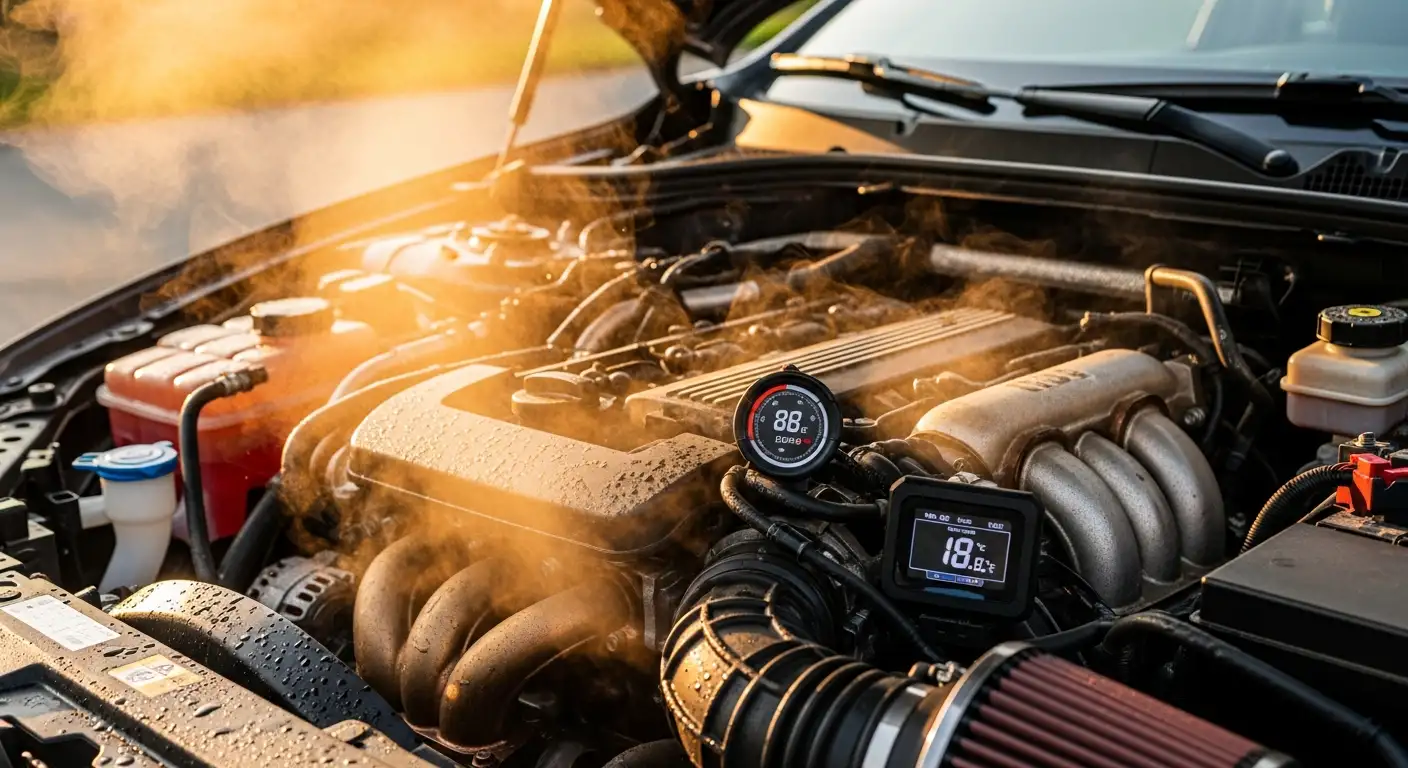
How Long to Wait Before Maintenance Work
Different maintenance tasks require varying cooling periods for safety and accuracy. Understanding these requirements prevents injury and ensures proper diagnosis.
How Long to Wait Before Changing Oil
Oil changes require strategic timing. Wait 10-15 minutes after driving for optimal oil change conditions. This allows oil to drain from the upper engine while remaining warm enough to flow freely. Warm oil (around 100-120°F) drains more completely than cold, removing more contaminants.
Conversely, waiting too long allows oil to cool and thicken, leaving residual oil in passages. The ideal oil change window is 10-30 minutes post-operation.
Checking Oil Hot or Cold
Oil level checking requires different approaches for accuracy:
Hot checking (Operating temperature):
- Wait 5-10 minutes after shutdown
- Oil has drained to pan
- Reading shows minimum safe level
- Accounts for thermal expansion
Cold checking (Overnight):
- Most accurate volume reading
- All oil has returned to pan
- Shows true capacity
- Best for detecting consumption
Autvex recommends checking both hot and cold periodically to understand your engine’s oil behavior.
How Long to Wait to Work on Car Engine
Work complexity determines required cooling time:
| Maintenance Task | Minimum Wait | Recommended Wait | Risk Level |
|---|---|---|---|
| Check fluids | 10 minutes | 30 minutes | Low |
| Replace air filter | 20 minutes | 45 minutes | Low |
| Spark plug change | 45 minutes | 90 minutes | Medium |
| Valve adjustment | 2 hours | 3 hours | High |
| Head gasket work | 3 hours | Overnight | Very High |
These times assume normal operating temperature. Add 50% for any overheating situation.
Is 30 Minutes Long Enough for an Engine to Cool Down
Thirty minutes provides adequate cooling for basic inspection but insufficient for most maintenance. At 30 minutes, the engine remains at approximately 120-140°F with residual pressure in the cooling system. This allows visual inspection and fluid level checks but not component removal or system opening.
Tasks safe at 30 minutes:
- Visual inspection
- Checking drive belts
- Battery maintenance
- Exterior cleaning
- Tire pressure check
Tasks requiring longer wait:
- Radiator cap removal (2+ hours)
- Coolant system work (2-3 hours)
- Exhaust work (1-2 hours)
- Internal engine work (3+ hours)
Factors Affecting Cool Down Time
Multiple variables influence how quickly your engine cools, making universal timeframes approximate rather than absolute.
Does Opening the Hood Help Cool Engine Faster
Yes, opening the hood significantly accelerates cooling. Tests show hood opening reduces cooling time by 20-30% through improved convection and radiation[7]. The enclosed engine bay traps heat, creating an insulation effect that slows natural cooling.
Hood opening benefits:
- Allows hot air to rise freely
- Increases airflow around components
- Improves radiator heat dissipation
- Reduces radiant heat reflection
- Prevents heat soak into surrounding parts
For maximum benefit, open the hood immediately after parking, ensuring the prop rod is secure.
Ambient Temperature and Engine Cool Down
Environmental temperature creates the gradient driving heat transfer. The greater the temperature difference between engine and surroundings, the faster initial cooling occurs. This relationship follows Newton’s Law of Cooling, where heat transfer rate is proportional to temperature difference.
Cooling time variations by ambient temperature:
- 32°F winter: 25% faster cooling
- 70°F moderate: Standard baseline
- 100°F summer: 40% slower cooling
- 115°F extreme: 60%+ slower cooling
How Long Does It Take for a Car to Cool Down in Winter vs. Summer
Seasonal temperature differences dramatically affect cooling rates. Winter cooling benefits from larger temperature gradients and potentially wind chill effects. Summer cooling suffers from minimal gradients and radiant heat from pavement.
Winter cooling (30°F ambient):
- Touch safe: 20-25 minutes
- Radiator cap safe: 60-90 minutes
- Ambient temperature: 90-120 minutes
Summer cooling (95°F ambient):
- Touch safe: 40-45 minutes
- Radiator cap safe: 120-150 minutes
- Ambient temperature: 180-240 minutes
Park in shade during summer to reduce radiant heat absorption and improve cooling rates.
Engine Size vs Cool Down Time
Larger engines contain more metal mass and coolant volume, requiring longer to dissipate heat. A V8 engine with 6-7 quarts of oil and 3-4 gallons of coolant holds substantially more heat energy than a 4-cylinder with half those volumes.
Cooling comparison by engine size:
- 4-cylinder: Baseline cooling rate
- V6: 15-20% longer cooling
- V8: 25-35% longer cooling
- Diesel: 30-40% longer (higher operating temp)
High-performance engines often feature additional cooling capacity but also generate more heat, resulting in similar cool-down times.
Aluminum vs Cast Iron Engine Block Cool Down
Material composition significantly impacts cooling rates. Aluminum dissipates heat 3-4 times faster than cast iron due to superior thermal conductivity (237 W/mK vs 55 W/mK)[2]. This means aluminum engines cool more quickly but also heat up faster during operation.
Material-specific cooling characteristics:
- Aluminum blocks: 20-30% faster surface cooling
- Cast iron blocks: Better heat retention, slower cooling
- Aluminum heads/Iron block: Mixed cooling rates
- Magnesium components: Fastest cooling but rare
Modern engines often combine materials, with aluminum heads on iron blocks creating differential cooling rates requiring careful consideration during maintenance.
How Long for a Turbo to Cool Down
Turbocharged engines require special cooling consideration. Turbos operate at extreme temperatures—exhaust side reaches 1,000°F+ while the intake side stays relatively cool. This temperature differential creates unique cooling challenges.
Turbo cooling requirements:
- Idle before shutdown: 30-60 seconds (oil circulation)
- Touch safe: 45-60 minutes
- Complete cooling: 3-4 hours
- Turbo timer recommended: For repeated hard driving
Modern turbo engines often include auxiliary cooling pumps that continue circulating coolant after shutdown, reducing required cooling time and preventing oil coking.
Safety Precautions and Warnings
Understanding the dangers of hot engine components prevents serious injuries and costly mistakes.
What Happens If I Open a Hot Radiator Cap
Opening a hot radiator cap triggers an immediate and violent release of superheated coolant and steam. The system pressure of 13-16 PSI suddenly drops to atmospheric, causing instant boiling of coolant above 212°F. This creates a geyser effect shooting steam and boiling coolant several feet upward and outward.
The sequence of events:
- Pressure seal breaks (instantaneous)
- Coolant flash-boils into steam (1-2 seconds)
- Steam/coolant mixture erupts (2-5 seconds)
- Continued boiling and overflow (10-30 seconds)
- System depressurization complete (30-60 seconds)
Medical data shows average treatment costs of $3,000-15,000 for radiator cap burns, with potential for permanent disfigurement[8].
Can I Open My Radiator Cap If the Temperature Gauge Is in the Middle
No, never trust the temperature gauge alone for radiator cap safety. The gauge indicates coolant temperature, not system pressure. Even at normal operating temperature (195-220°F), the system maintains 13-16 PSI pressure, increasing coolant’s boiling point to approximately 250-260°F[6].
Pressure presence indicators:
- Hissing sounds near cap
- Cap difficult to turn initially
- Visible vapor from overflow tube
- Radiator hoses feel firm
- Recent engine operation
Always wait minimum 2-3 hours regardless of gauge reading, and test cap temperature with back of hand first.
Is It Safe to Add Oil to a Hot Engine
Adding oil to a hot engine is generally safe but requires precautions. Unlike the pressurized cooling system, the crankcase vents to atmosphere through the PCV system. However, hot oil can splash, and temperature differentials between cold oil and hot components can cause issues.
Safety guidelines for hot oil addition:
- Wait 10-15 minutes after shutdown
- Remove oil cap slowly (may have vapor)
- Pour slowly to prevent splashing
- Avoid overfilling (hot oil reads higher)
- Never exceed maximum mark
Cold oil added to extremely hot engines may not flow properly initially, potentially causing brief oil starvation. Synthetic oils handle temperature variations better than conventional oils.

Key Takeaways
- Minimum 30 minutes for basic engine inspection and touching metal surfaces safely
- Wait 1-2 hours before opening radiator cap under any circumstances
- Complete cooling takes 2-3 hours to reach ambient temperature for major work
- Overheated engines need 50-100% more cooling time than normal operation
- Opening hood reduces cooling time by 20-30% through improved air circulation
- Never add coolant directly to hot radiator – use overflow reservoir after 30-45 minutes
- Aluminum engines cool 20-30% faster than cast iron due to better heat conductivity
Next Steps
Begin by investing in an infrared thermometer ($20-50) to accurately measure component temperatures without contact. This eliminates guesswork and provides precise data for safe maintenance timing. Install an auxiliary temperature gauge if your vehicle lacks one, as factory gauges often lack precision for diagnostic purposes.
For overheating situations, create an emergency kit including extra coolant, distilled water, heavy gloves, and safety glasses. Know your vehicle’s normal operating temperature range and cooling system capacity. Program roadside assistance numbers and locate nearby service centers before problems occur.
Establish a cooling system maintenance schedule: check coolant levels monthly, inspect hoses seasonally, and flush the system per manufacturer recommendations (typically 30,000-50,000 miles). Consider upgrading to a higher-pressure radiator cap (within manufacturer specifications) to raise the boiling point by 3°F per PSI increase.
Most importantly, practice patience. The few extra minutes spent waiting for proper cooling prevents injuries and expensive repairs. Use cooling time productively—inspect other vehicle components, check tire pressure, or review maintenance records. Remember that rushing leads to mistakes, and radiator burns heal slowly. When in doubt, wait longer or seek professional assistance for cooling system work.
FAQs
How long does it take for a car engine to cool down completely?
Complete cooling to ambient temperature takes 2-3 hours under normal conditions, but the engine is safely touchable after 30 minutes and ready for most maintenance after 1-2 hours.
How long should I wait before opening my radiator cap?
Wait at least 2-3 hours or until the upper radiator hose feels completely cool to touch. Never open when hot due to explosive release of pressurized steam at 250°F+.
My car overheated. How long until I can drive it again?
Wait minimum 30-45 minutes for temperature to normalize completely. Check coolant levels, address the underlying cause, and monitor temperature constantly if you must drive.
Is it safe to add coolant to a hot engine?
Never add coolant directly to a hot radiator—risk of explosion and burns. Use the overflow reservoir after 30 minutes minimum, or wait 2+ hours to safely open the radiator cap.
How can I make my car cool down faster after overheating?
Open the hood immediately for 20-30% faster cooling, turn heater to maximum, park in shade with good airflow. Never use water directly on the engine block.
How long should I wait to check my oil after driving?
Wait 10-15 minutes for accurate level reading as oil needs time to drain back to the pan. For oil changes, 30-60 minutes provides ideal warm-but-safe temperature.
Is 30 minutes long enough for an engine to cool down?
30 minutes suffices for basic inspection and touching most surfaces, but not for opening the radiator cap or performing major maintenance work requiring complete cooling.
Can I open my radiator cap if the temperature gauge is in the middle?
No, the gauge shows temperature not pressure. Even at normal operating temperature, the system maintains 13-16 PSI pressure with coolant at 250°F—extremely dangerous.
What happens if I open a hot radiator cap?
Pressurized coolant and steam violently erupt at temperatures exceeding 250°F, causing severe burns instantly. The system maintains 13-16 PSI pressure creating explosive release.
How long does it take for a car to cool down in winter vs. summer?
Winter cooling is 25-40% faster due to greater temperature differential. Summer may require 3+ hours for complete cooling versus 2 hours in winter conditions.
Is it safe to add oil to a hot engine?
Yes, but wait 10-15 minutes after driving for safety. Hot oil can splash, and extreme temperature differences between cold oil and hot engine should be avoided.
References
- SAE International. (2025). Automotive Cooling System Standards and Testing. https://www.sae.org
- Langhe Industry. (2025). Cast Aluminum vs Cast Iron – Thermal Properties Comparison. https://langhe-industry.com/cast-aluminum-vs-cast-iron/
- Chalmers University. (2025). Real Time Modeling of Engine Coolant Temperature. https://odr.chalmers.se
- National Institute for Automotive Service Excellence. (2025). Engine Operating Temperature Standards. https://www.ase.com
- AAA Foundation for Traffic Safety. (2025). Engine Overheating Damage Statistics. https://www.aaa.com
- JB Tools Inc. (2025). Radiator Cap Pressure Ratings and Safety. https://www.jbtools.com/blog/what-are-pressure-ratings-for-radiator-caps/
- CarParts.com. (2025). How Long Does It Take a Car to Cool Down? https://www.carparts.com/blog/how-long-does-it-take-a-car-to-cool-down/
- Consumer Product Safety Commission. (2025). Automotive Cooling System Injury Statistics. https://www.cpsc.gov

I am a senior automotive analyst at Autvex. Expert vehicle evaluations, in-depth reviews, and objective analysis helping readers make informed automotive decisions with years of industry experience.

